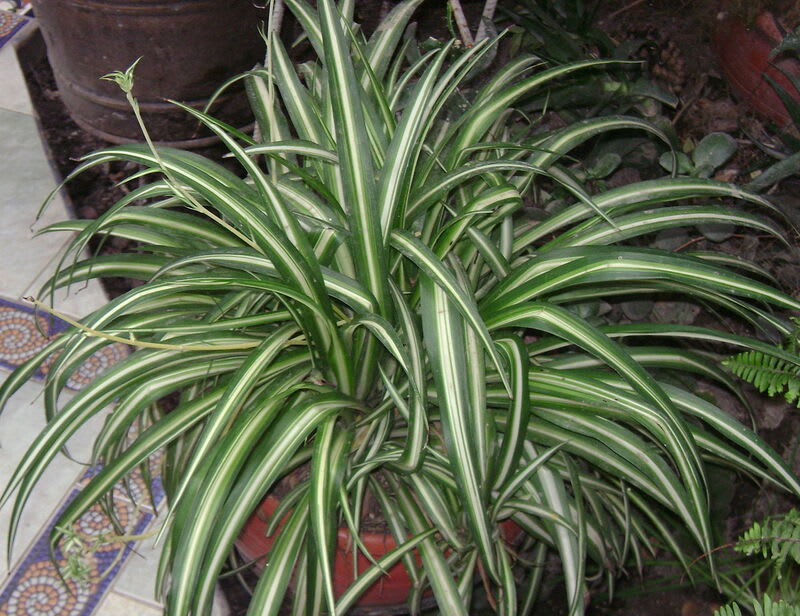Spider plant, Ribbon plant, Airplane plant, St. Bernard's lily, Spider ivy
Chlorophytum comosum

🌿 Morphology
🌞 Growing conditions
🌍 Origin and family
🌾 Uses
Warning: Despite the care taken in writing this sheet, it is essential to cross-reference sources before using or consuming any plant. When in doubt, consult a qualified professional
Permaculture uses
Primarily used as an ornamental plant, excellent for purifying indoor air by removing toxins like formaldehyde and xylene. The leaves are technically edible but not palatable and are generally not recommended for consumption. Can be used as a ground cover in frost-free climates.
Permapeople description
Chlorophytum comosum grows to about 60 cm (24 in) tall, although as a hanging plant it can descend many feet. It has fleshy, tuberous roots, each about 5–10 cm (2–4 in) long. The long narrow leaves reach a length of 20–45 cm (8–18 in) and are around 6–25 millimetres (0.2–1.0 in) wide.
Flowers are produced in a long, branched inflorescence, which can reach a length of up to 75 cm (30 in) and eventually bends downward to meet the earth. Flowers initially occur in clusters of 1–6 at intervals along the stem (scape) of the inflorescence. Each cluster is at the base of a bract, which ranges from 2–8 cm (0.8–3.1 in) in length, becoming smaller toward the end of the inflorescence. Most of the flowers that are produced initially die off, so that relatively, the inflorescences are sparsely flowered.
Individual flowers are greenish-white, borne on stalks (pedicels) some 4–8 mm (0.2–0.3 in) long. Each flower has six triply veined tepals that are 6–9 mm (0.2–0.4 in) long and slightly hooded or boat-shaped at their tips. The stamens consist of a pollen-producing anther about 3.5 mm (0.1 in) long with a filament of similar length or slightly longer. The central style is 3–8 mm (0.1–0.3 in) long. Seeds are produced in a capsule, 3–8 mm (0.1–0.3 in) long, on stalks (pedicels) that lengthen to up to 12 mm (0.5 in).
The inflorescences carry not only flowers but also vegetative plantlets at the tips of their branches, which eventually droop and touch the soil, developing adventitious roots. The stems (scapes) of the inflorescence are called "stolons" in some sources, but this term is more correctly used for stems that do not bear flowers and have roots at the nodes.
Botanical description
Chlorophytum comosum is a perennial herbaceous flowering plant of the Asparagaceae family. It grows to about 60–75 cm (24–30 in) tall. It has long, narrow leaves that are about 20–45 cm (8–18 in) long and 6–25 mm (0.2–1.0 in) wide. The flowers are small, white, and are produced on long, pendant panicles (up to 90 cm (35 in) long). After flowering, plantlets form at the nodes on the panicles, eventually drooping to the ground and rooting. The most common variety is 'Variegatum', which has green leaves with white stripes.
Companion planting
Generally a good companion plant indoors, helping to improve air quality. Outdoors, it can be grown under trees or shrubs that provide shade. No significant antagonistic relationships are known.
Propagation methods
Easiest propagation method is by rooting the plantlets that develop on the flower stems. Simply detach the plantlets and plant them in potting soil. Can also be propagated by division of mature plants or by seed, although seed propagation is less common.
History and traditions
Native to tropical and subtropical regions of Africa. Has become a popular houseplant worldwide since the late 19th century. There are no significant traditional medicinal uses reported, but it is highly valued for its air-purifying qualities in modern interior design.
Usage calendar
Plantlets can be removed and rooted at any time of year. Flowering typically occurs in spring and summer. Repotting is best done in spring.
